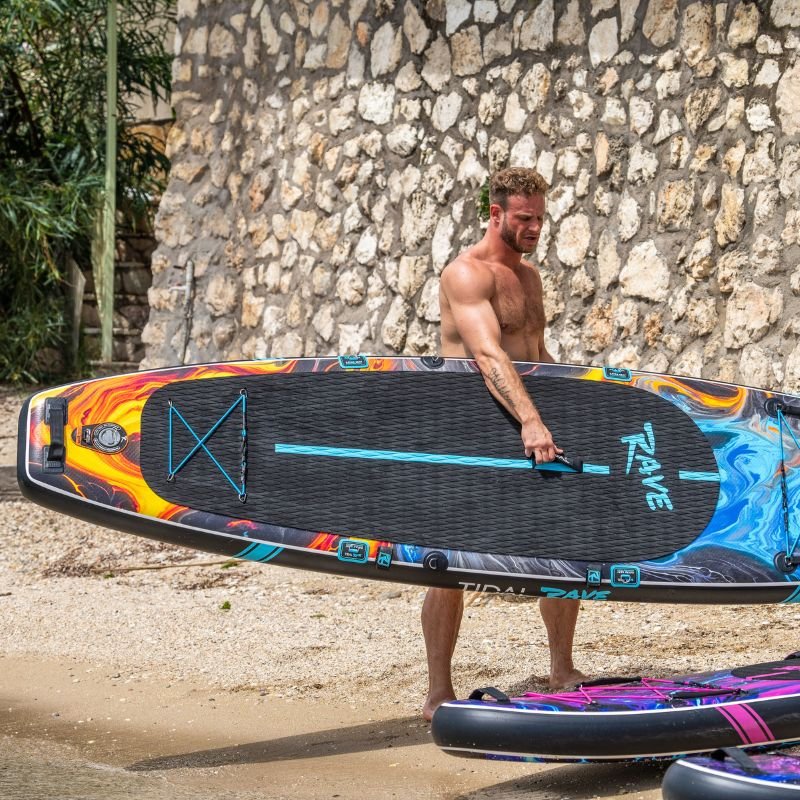Embarking on a paddle boarding adventure? Fantastic choice! But before you hit the serene waters or catch those waves, there’s the critical step of getting your board to the shoreline safely.
Strapping a paddle board to a roof rack might seem like a daunting task, but fear not! We’ve got a straightforward, step-by-step guide to ensure your paddle board arrives as ready for the adventure as you are. Plus, we'll also go over some essential accessories for paddle boarding to enhance your experience, so you’re fully equipped all-round.
Let's dive in!
Essential Materials for Securing Your Paddle Board
First thing’s first: gathering your materials. You'll need:
- A roof rack (preferably with crossbars)
- Two tie-down straps
- A protective pad or towel to prevent scratching
Preparing Your Paddle Board
Before you place your board on the roof, ensure it's clean and dry to avoid slipping. If you’re using an inflatable stand up paddle board, ensure it's fully inflated and firm. Position your board on the roof rack with the fin up (if detachable, remove and store inside your vehicle) and towards the front of the car to minimise wind resistance.
Securing the Paddle Board
Here’s where precision matters: place the protective pad or towel under the board to shield it from scratches, then, loop the first tie-down strap over the board’s centre, threading it underneath the roof rack’s cross bars and back over. Pull the strap tight, ensuring there’s no slack, but be careful not to overtighten and damage the board. Repeat this process with the second strap at the board’s tail or nose for added security.
Additional Tips for Stability
Worried about your board wobbling during the drive? Utilise a third strap around the board's nose or tail (whichever end doesn’t already have a strap) and attach it to the front or back of your vehicle. This extra step significantly enhances stability during transit.

Safety Measures
Safety should always be your top priority. Double-check that all straps are securely fastened and that the board doesn’t shift when gently nudged. It’s advisable to check the straps again after driving a short distance, as they can loosen when the vehicle is in motion.
Driving Tips and Cautionary Measures
Adjust your driving style when transporting a paddle board. Avoid sudden stops or sharp turns, which could cause the board to shift or even detach. Keep an eye on the maximum speed recommended for vehicles carrying roof loads.
Remember, safety first!
Unloading Your Paddle Board
Upon reaching your destination, carefully unstrap and remove your paddle board. Check for any signs of wear or damage from the straps or journey. Now, you’re all set to hit the water and enjoy your paddle boarding adventure
Remember, proper care and transportation of your paddle board can significantly extend its lifespan, ensuring many more adventures to come. For those looking to upgrade their gear or get started, don’t miss our essential guide on the inflatable stand up paddle board, a versatile choice for beginners and seasoned paddlers alike.
So, whether you're a first-timer or a seasoned pro, strapping a paddle board to your roof rack is an essential skill that ensures your board's safety and yours. And by following this guide, you can rest assured that your paddle board will arrive securely at your destination, ready for whatever adventures await. So, what are you waiting for? It's time to strap up and paddle out!
FAQs
Can I transport two paddle boards on one roof rack?
Yes, you can transport two paddle boards on a single roof rack if there’s sufficient space. Stack the boards on top of each other, with a protective layer between them to prevent damage. Secure both boards using the tie-down straps as outlined, ensuring the straps are tight and the boards are stable before setting off.
What if my vehicle doesn’t have a roof rack?
If your vehicle doesn’t have a roof rack, there are temporary roof rack solutions designed for such scenarios; these systems typically involve soft pads that sit on the roof of your car and straps that run through the interior of the vehicle.
However, ensure the temporary solution is sturdy enough to safely transport your paddle board.
How tight should the straps be?
The straps should be tight enough to securely hold the paddle board in place without causing damage. Over-tightening can dent or warp your board, especially if it's made of a softer material like foam. A good rule of thumb is to tighten the straps so there’s no movement of the board when you gently push against it, but you should still be able to slide a finger under the strap.
Can I leave my paddle board strapped to the car overnight?
It’s not a good idea to leave your paddle board strapped to your car overnight, especially in public or unsecured areas due to the risk of theft. Additionally, prolonged exposure to elements like the sun or rain can potentially damage your board. If you must leave your board on your vehicle, consider a board lock and try to park in a secure, shaded area.




